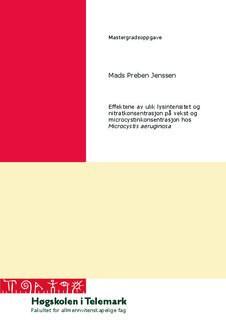| dc.contributor.author | Jenssen, Mads Preben | |
| dc.coverage.spatial | Telemark | |
| dc.date.accessioned | 2014-09-09T08:20:56Z | |
| dc.date.accessioned | 2017-04-19T13:13:50Z | |
| dc.date.available | 2014-09-09T08:20:56Z | |
| dc.date.available | 2017-04-19T13:13:50Z | |
| dc.date.issued | 2014 | |
| dc.identifier.citation | Jenssen, M. P. Effektene av ulik lysintensitet og nitratkonsentrasjon på vekst og microcystinkonsentrasjon hos Microcystis aeruginosa. Master thesis, Telemark University College, 2014 | |
| dc.identifier.uri | http://hdl.handle.net/11250/2438930 | |
| dc.description.abstract | Oppblomstring og toksinproduksjon hos cyanobakterier har lenge vært et problem verden over og det er mye forskning på dette området. En av de bakteriene som det er forsket mest på er Microcystis aeruginosa, og som produserer toksinet microcystin. De to viktigste elementene for vekst og microcystinproduksjon er lys og temperatur, mens andre viktige elementer er nitrogen, fosfor og fem sporstoffer. I denne oppgaven har vekst og microcystinkonsentrasjon ved ulik lysintensitet og nitratkonsentrasjon blitt studert. I denne studien ble en ikke-microcystinproduserende mutant (MCYB-) og en toksisk stamme av M. aeruginosa undersøkt (PCC 7806) under lav (8 μE) og høy (104 μE) lysintensitet og med ulike nitratkonsentrasjoner (normalt O2-medium og 1/50 av normal nitratkonsentrasjon (10 mg NaNO3/L)). Dyrkingsforsøkene varte i 4 uker, med uttak av prøver til analyse hver andre dag. Lys var det mest avgjørende for vekst og microcystinkonsentrasjon. Nitrat var begrensende for vekst og microcystinkonsentrasjon ved lavere lysintensitet hvor omdanninga av nitrat til ammonium ikke ble hemmet av høy lysintensitet. Ved høy lysintensitet virket lyset som en stressfaktor fordi vekst og microcystinkonsentrasjon ble betydelig lavere enn ved lav lysintensitet, uavhengig av nitratkonsentrasjonen. Begge stammene hadde likt vekstmønster ved lav lysintensitet. Ved høy lysintensitet hadde mutanten en lag-fase på 12 dager og toksinprodusenten en lag-fase på 18 dager. Mutanten hadde like god vekst ved høy lysintensitet som ved lav lysintensitet. Dette kan tyde på at mutanten tilpasser seg overgangen til høy lysintensitet bedre og raskere enn den toksiske stammen. Alt i alt viser dette at lys og nitrat er to viktige faktorer for microcystinproduksjon og vekst. | |
| dc.description.abstract | Blooming and toxin production of cyanobacteria has long been a problem world wide and there is much research on this area. One of the most-studied cyanobacteria is Microcystis aeruginosa, which produces the toxin microcystin. The two most important factors for growth and microcystin production are light and temperature, but other important factors are nitrogen, phosphorus and five microelements. In this study, growth and microcystin levels at different light intensity and nitrate concentrations has been studied. In this study, a non-toxigenic mutant (MCYB-) and a toxic strain of M. aeruginosa (PCC7806) were cultivated under low (8 μE) and high (104 μE) light intensity and with different nitrate concentrations (normal O2-medium and 1/50 of normal nitrate concentrations (10 mg NaNO3/L). The cultivation experiments lasted for 4 weeks each and with samples taken for analysis every second day. Light was the most important factor for growth and microcystin production. Nitrate was limiting for growth and microcystin concentration at lower light intensity where the transformation of nitrate to ammonium was not inhibited by high light intensity. At high light intensity the light functions as a stress factor and growth and microcystin production were much lower than at low light intensity, independent of the nitrate concentrations. Both strains had similar growth patterns at low light intensity. At high light intensity the mutant had a lag phase of 12 days and the toxic strain had a lag phase of 18 days. The mutant had the same good growth at high light intensity than at low light intensity. This may indicate that the mutant strain adapts to the transition to high light intensity better and faster than the toxic strain. All in all this demonstrates that light and nitrate are two important factors for microcystin production and growth. | |
| dc.language.iso | nob | |
| dc.publisher | Høgskolen i Telemark | |
| dc.subject | microcystis aeruginosa | |
| dc.subject | cyanobakterier | |
| dc.subject | toksinproduksjon | |
| dc.subject | microcystin | |
| dc.title | Effektene av ulik lysintensitet og nitratkonsentrasjon på vekst og microcystinkonsentrasjon hos Microcystis aeruginosa | |
| dc.type | Master thesis | |
| dc.description.version | Published version | |
| dc.rights.holder | © Copyright The Author. All rights reserved | |
| dc.subject.nsi | 472 | |
